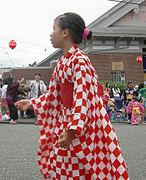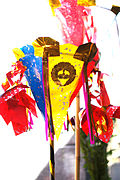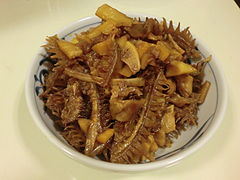Obon
O-bon ( Japanese お 盆 , 御 盆 ) or just Bon ( 盆 ; the “ O ”, “ お ”, “ 御 ” is a Japanese honorific prefix ) is a traditional Buddhist festival and holiday in Japan to save the souls of deceased ancestors. This originally Confucian- Buddhist custom serves not only to spiritually bring family members together between the afterlife and this world , but also as an occasion for family get-togethers, whose members sometimes live far apart due to different life situations. The family festival O-bon has both a religious and a social role and meaning in the folk race .
etymology
The word Obon is a shortened form of Urabon - jap. 盂蘭盆 , 于蘭盆 , kana うらぼん ; chin. 孟蘭 盆 / 孟兰 盆 , Yúlánpén - a Japanese loan name of the Sanskrit word ullambana - उल्लम्बन , also avalambana - Japanese 盂蘭盆 會 urabon'e ; Chinese 孟蘭 盆 會 / 孟兰 盆 会 , Yúlánpénhuì - for "hanging and suffering upside down in hell", which is what the " hunger spirits " - Sanskrit प्रेत preta ; jap. 餓鬼 , が き gaki ; chin. 餓鬼 / 饿鬼 , èguǐ happens, but they are allowed to return once a year from the underworld to this world.
Emergence
The origins of Obon go back to the Hindu Dīvalī festival (also Dīpāvalī festival, festival of lights), merged with Avalambana - Ullambana , the feeding of the preta ("hungry spirits") - and the Taoist rites of the " Zhōngyuán festival " held on the same day “- Japanese 中元 Chūgen , with the honorary prefix “ O ”, also お 中元 Ochūgen - back. Their symbolic feeding is supposed to alleviate their suffering in hell.
The corresponding Avalambana Sutra - also called Ullambana Sutra - Japanese. 孟蘭 盆 経 Urabon-kyō ; Chinese 孟蘭 盆 經 / 孟兰 盆 经 , Yúlánpénjīng , translated by the Buddhist monk and sutra translator Dharmaraksha - Japanese 竺 法 護 Jiku Hōgo ; Chinese 竺 法 護 / 竺 法 护 , Zhú Fǎhù , * approx. 233 - at the time of the Western Jin (265–316), succeeded as a Chinese translation at the time of the Sui (581–619) and Tang (618–907) in the period of the Asuka period (538 or 592–710) to Japan . In it, the multifaceted ceremonial of the All Souls Day - initially on the 15th and later on the 13th-16th of the seventh lunar month 1 - with All Souls Sacrifice urabon-kuyō ( 盂蘭盆 供養 ) - especially for father and mother of the current and seven previous generations - shown as originating from Shakyamuni . A copy from the Japanese side from the 15th year Tempyō ( 天平 , 743) has been preserved.
The introduction of the "light component" of the O-bon - called the "Lantern Festival" by Basil Chamberlain - did not take place in Japan until 1230 by order of Go-Horikawa - tennōs . The burning of pyre, often in the form of a large Kanji character, for example Dai - 大 , hence Daimonji no hi - 大 文字 の 火 'fire of the large characters' - on the evening of the 16th is said to go back to Kōbō Daishi . In any case, it has its origins in Shingon or Tendai rites. The tantric school has also created a variety of preta-feeding sacrificial rites (including Segaki-ho, Ikitama-e ).
On the last evening at the Tōrō nagashi lanterns are floated to guide the souls of the deceased.
This originally religious Buddhist festival has now also become a family reunification holiday, when people from the big cities come back to their hometowns and visit and clean the graves of their ancestors.
Traditionally associated with a dance festival, the obon has existed in Japan for more than 500 years. The Obon festival traditionally lasts three days and is held in the eastern part of Japan (e.g. Kantō , Tōhoku , Tokyo ) from July 13th ("Welcome Obon") to July 15 or 16 ("Farewell Obon “) Celebrated in July and therefore also Shichigatsu-Bon - 七月 盆 'Obon in July' . In the western and the rest of Japan (e.g. Chūgoku , Shikoku , Kagoshima , Okinawa ) the celebration takes place in August from 13-15. instead and is therefore also called Hachigatsu-Bon - 八月 盆 'Obon in August' . In some areas of Japan the festival is still celebrated according to the traditions of the "Alt-O- bon " - Kyū-bon 旧 盆 'Alt-Bon' - according to the rarely used bound lunar calendar . The reason for the regional differences in the date has to do with the historical calendar change at the beginning of the Meiji period from the traditional Japanese calendar with the bound lunar calendar to the "modern times" with the Gregorian calendar . In recent years, most parts of Tokyo put the Obon on the August summer vacation season.
The dances associated with the Obon are derived from the story of a disciple of the Buddha, Maudgalyāyana (Japanese 目犍連 mokukenren , also 目 連 Mokuren ), who saw his deceased mother in a vision in the "kingdom of hungry spirits", where she was of selfishness. Horrified, he went to the Buddha and asked how he could free his mother from this spirit realm. The Buddha replied to hold a great festival on July 15th for the last seven generations of the dead. The disciple did this and thus achieved the deliverance of his mother. At the same time he recognized her selflessness and the many sacrifices she had made for him. The disciple danced for joy, happy for his mother's release and grateful for her kindness.
Derived from this dance of joy is the Bon Odori ( 盆 踊 り 'Bon dance' ), with which the ancestors and their victims are remembered during the O-bon.
Obon corresponds to the Buddhist Ullambanafest or the Chinese Ghost Festival and resembles the Mexican Día de los Muertos , in some aspects, the Christian All Souls Day .
- annotation
Traditions
The obon is celebrated all over Japan, since it takes place in the summer months, many Japanese wear a yukata as a "light version" of the traditional kimono . The type of celebration traditionally differs from region to region.
At the house altar ( Butsudan ) or in Buddhist temples, dishes for the ancestors are placed, which can be supplemented with decorative elements such as a cucumber and eggplant . These symbolize the mounts horse and cattle - Shōryō-uma ( 精 霊 馬 'soul horse ' ), Shōryō-ushi ( 精 霊 牛 'soul cattle ' ) - with which the dead return to this world. The fast "soul horse" brings the souls of the relatives quickly into the family home in this world and the slow "soul cattle" brings the souls of the family members back to the hereafter. In some areas of Japan, towards the end of the festival, gifts are placed on the altars by children for Jizo , the Bodhisattva who cares for the deceased children in the afterlife.
Bon Odori
Originally, the people danced Nenbutsu to greet the spirits of the dead. The individual areas of Japan often have their own way of dancing the Bon Odori ( 盆 踊 り 'Ullambana dance' ) and their own music. So is z. B. the Awa Odori ( 阿波 お ど り , 阿波 踊 り ) from Tokushima prefecture is quite different from the Gujō Odori ( 郡 上 お ど り , also 郡 上 踊 り ) from Gifu prefecture . The Frankfurt Ondo , which was composed on the occasion of the 150-year-old relationship between Japan and Germany, has existed in Frankfurt am Main since 2011 . The music played ranges from classical music to traditional Japanese music such as Makkō Ondo .
Okuribi
In addition to the dance, there is also the fire ritual Okuribi ( 送 り 火 'escort fire' ) with which the family welcomes the souls of the deceased ancestor with a "welcome fire " at the house ( 迎 え 火 mukae-bi ) and at the end of the festival with an "escort fire" them back into the house Beyond sends ( 送 り 火 okuri-bi ).
The ritual Gozan no Okuribi ( 五 山 送 り 火 'Escort of the five mountains' ) is z. B. a well-known tradition in Kyoto , which is usually known colloquially as daimonji ( 大 文字 , large characters' ). This local custom is not known anywhere outside of Japan and is therefore something special.
photos
- Bon Odori dance
Mi Kokoro Ondo - Dance, Seattle 2007
Hiroshima Ondo - Dance, Seattle 2007
Bon Odori, Seattle 2007
Bon Odori, Seattle 2011
Bon Odori, Seattle 2011
- Different o-bon traditions
Bondoro - 盆 燈籠 - Grave Lantern, Japan 2007
Shinbon Chōchin - 新 盆 提 灯 , Katori 2008
Cucumbers and eggplants - offering - お 膳 ozen - at the grave, Katori 2008
Okuri- Dango - 送 り 団 子 , Japan 2008
See also
literature
- Marinus Willem de Visser: Ancient Buddhism in Japan - Sutras and Ceremonies in Use in the 7th and 8th Centuries AD and their History in Later Times . 2 volumes, Paul Geuthner, Paris 1928–1931; Brill, Leiden 1935.
- Adolf Barghoorn et al .: Kokumin Nenjū gyōji - The year in the experience of the people . OAG , Tōkyō; Asia Major , Leipzig 1926.
- H. Weipert: The Bon Festival . In: Communications from the German Society for Nature and Ethnology of East Asia . Vol. VIII (3 parts 1899-1901), ISSN 0027-0741 , pp. 145-173; with 9 panels.
- Hisayoshi Takeda: annual tradition in the Japanese village . In: Asian Folklore Studies . Vol. 8, 1949, ISSN 0385-2342 , pp. 1-362. ( PDF ; 24 MB)
- Kunio Yanagita: About our Ancestors . Greenwood Press, New York 1970, ISBN 0-313-26552-6 (reprint)
- Robert J. Smith: Ancestor Worship in Contemporary Japan , Stanford University Press, Stanford, California 1974. ISBN 0-8047-0873-8
- Ulrich Pauly: The Japanese Festival of the Dead (Bon Festival) . In: OAG Notes . No. 6 , 2012, p. 9–32 ( PDF ; 9.6 MB).
Web links
- Bon Dance - 盆 踊 り の 世界 'The world of bon dances' - Spiritual Dance in Midsummer Night. In: bonodori.jp (English, Japanese)
Individual evidence
- ↑ a b c d e f Religion - Obon Festival. In: jref.com. August 12, 2019, accessed on July 6, 2020 (English, References: Frédéric, Louis, Japan Encyclopedia, Harvard University Press 2002).
- ↑ a b c d e Summer: Obon Season in Japan. In: www.osakajoe.com. August 15, 2016, accessed on July 6, 2020 .
- ↑ a b c d お 盆 - Obon. In: www.learnjapan.co. August 15, 2015, accessed on July 6, 2020 .
- ↑ Term “gaki - 餓鬼, が き, ガ キ”. In: Wadoku . Retrieved January 31, 2019 (German, Japanese).
- ↑ Term “gaki - 餓鬼, が き, ガ キ”. In: tangorin.com. Retrieved January 31, 2019 (English, Japanese).
- ↑ Term “èguǐ - 餓鬼 / 饿鬼”. In: www.zdic.net. Retrieved January 31, 2019 (Chinese, English).
- ↑ Term “èguǐ - 餓鬼 / 饿鬼”. In: dict.revised.moe.edu.tw. Retrieved January 31, 2019 (Chinese, English).
- ^ Term "kyu bon - 旧 盆". In: Wadoku . Retrieved July 6, 2020 (German, Japanese).
- ↑ term "Maudgalyayana -目犍連,目連". In: Wadoku . Retrieved July 6, 2020 (German, Japanese).
- ↑ 精 霊 馬 - Shōryō Uma. In: www.learnjapan.co. August 15, 2015, accessed on July 6, 2020 .
- ↑ 精 霊 馬 っ て な に? 読 み 方 ・ 作 り 方 は? キ ュ ウ リ と ナ ナ ス の 由来 も 解説 !! In: omatsurijapan.com/. May 7, 2020, accessed July 6, 2020 (Japanese).
- ↑ お 盆 に な す と き ゅ う り を 飾 る 牛 、 馬 の 意味 っ て 何? 精 霊 霊 馬 の 作 り 方 は? In: butudan-ec.minrevi.jp. Retrieved July 6, 2020 (Japanese).
- ^ Robert Ellwood: Introducing Japanese Religion. 2nd Edition. Routledge, New York 2016, ISBN 978-1-138-95875-3 , pp. 42 , doi : 10.1525 / no.2010.13.3.126 (English, full text in the Google book search - 2nd edition, description ).
- ↑ Japanese dance for participation in FAZ of August 18, 2014, page 30.
- ↑ Term “uchikabi - 紙 銭 / う ち か び”. In: www.okistyle.com. Retrieved July 5, 2020 (English, Japanese, more precisely: Japanese Ryūkyū - Okinawa ).
- ↑ Money for the afterlife, “Uchikabi” production springs into peak production as the Okinawan shimi season kicks off. In: english.ryukyushimpo.jp. April 6, 2020, accessed July 5, 2020 (English, Japanese, English translation by T&CT, Sam Grieb).























